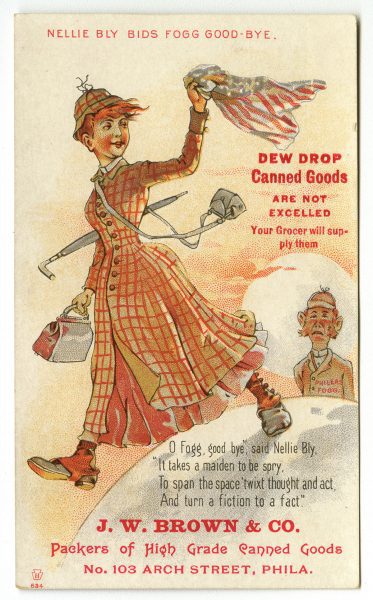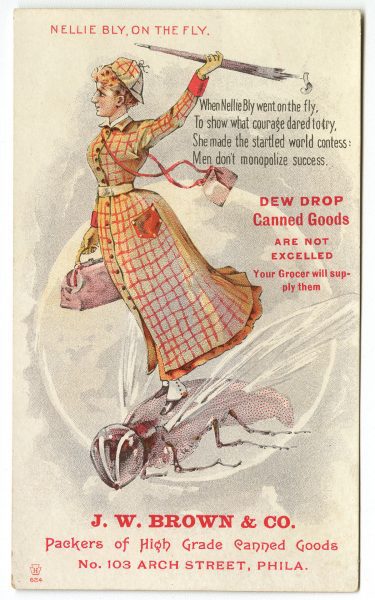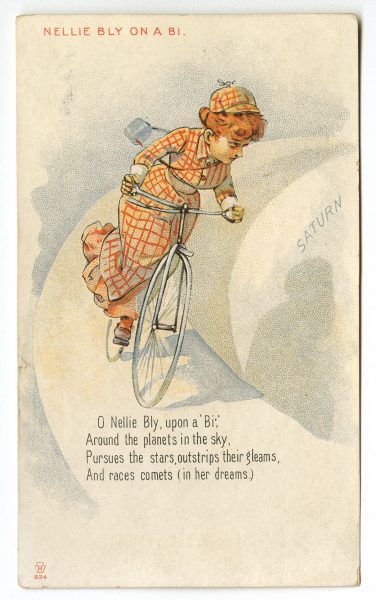Exploits of Nellie Bly Advertised On Trade Cards
J. W. Brown & Co., High Grade Canned Goods, No. 103 Arch Street, Phila. (Philadelphia, ca. 1890). Nellie Bly is shown walking away from Phileas Fogg, the main character of Jules Vernes’ Around the World in Eighty Days.
While working with the Richard and Rosalind Berman Collection of Philadelphia Trade Cards, I discovered three cards that promote journalist Elizabeth Cochran, better known by her journalism pseudonym Nellie Bly, and her expedition across the globe. Despite advertising two different businesses, the cards are a single series. Their printer mass produced these cards, and individual companies bought them and later stamped or printed their own business information on them. Two of these cards advertise the canned goods manufacturer J. W. Brown & Company, while the other advertises the Wilson Biscuit Company. Bly is shown walking away from Phileas Fogg, the protagonist of Jules Verne’s Around the World in Eighty Days and inspiration for Bly. She also uses an oversized fly as a means for transport and rides a bicycle on the ring of Saturn. These trade cards reveal that Americans identified Nellie Bly primarily with her gender, but also as an adventurer and an American whose reporting provided entertainment as well as information.
In 1890, Bly set off to travel around the world. Bly had already established herself as a journalist by reporting under cover on the conditions of an insane asylum where she had been committed after faking psychosis. This style of reporting made Bly a pioneer in the genre of “stunt girl” journalism. Towards the latter half of the nineteenth century, newspapers as a mode of media began to evolve. The publications focused on tabloid-like gossip about social elites and balls and interviews became more invasive (Tuchner 50-51). Adventure journalism that detailed excursions around the world and appealed to Americans’ support of Manifest Destiny became popular (Cronin 24). Somewhere along the way, the trade produced stunt girls, female journalists who would place themselves in bizarre, dangerous, or otherwise sensational situations about which to report. Bly became the best known of these stunt girls (Lutes 218).
W. Brown & Co., High Grade Canned Goods, No. 103 Arch Street, Phila. (Philadelphia, ca. 1890). Bly is portrayed riding a fly, along with her travel bags and umbrella.
Wilson Biscuit Co., Manufacturers of Faultless Biscuit, Cakes, and Crackers, 210, 212, 214 N. Front Street, Philadelphia (Philadelphia, ca. 1890). Bly rides a bicycle on a ring around Saturn.
The absurd illustrations and rhyming captions on the cards portray Bly and her adventure as whimsical. All three cards rhyme “Bly” with the last word of the title, and all contain a poem comprised of a pair of couplets. The jaunty rhyming scheme and comedic portrayal of her create an image of Bly that is entertaining, novel, friendly, and silly. The surreal images of her traversing the rings of Saturn by bicycle and traveling via insect create the idea that her work is entertainment as much as it is reporting. Her informal and witty writing style in Around the World in Seventy-Two Days also cultivates this image. She often humorously recounts events on her travels, such as becoming sea sick on her first boat trip during her excursion.
The advertisements depict the multiple identities of Bly with woman as the most primary of them. As a stunt girl, Bly depended on her femininity to attract readers. Her feats were inherently interesting, but her stories about them were more interesting to read. Both the audience and Bly were aware that her vulnerability as a woman in a world dominated by men gripped the reader (Lutes 218). This is noted by Bly in her opening chapter of Around the World in Seventy-Two Days, when her editor at first denies her request to go on the trip, saying that “they had thought of this same idea before and the intention was to send a man” and that she was “a woman and would need a protector.” The poem on the trade card titled “Nellie Bly Bids Fogg Good-Bye” reads: “‘O Fogg, good bye,’ said Nellie Bly, ‘It takes a maiden to be spry, to span the space ‘twixt thought and act, And turn a fiction to a fact.’” “Nellie Bly, On The Fly” reads “When Nellie Bly went on the fly, To show what courage dared to try, She made the startle world confess: Men don’t monopolize success.” Both of these poems acknowledge that Bly was doing something extraordinary, but their themes capitalize on her prescribed role as a woman. However, the illustrations on all three cards also portray her as an adventurer, going to new lands in strange ways. Additionally, her identity as an American is present as she waves a flag towards Fogg.
The Nellie Bly promoted as intrepid reporter and American traveler is illustrated in this series of trade cards. The eccentric illustrations and jovial poems on each one creates an image of Bly that is entertaining and endearing. This portrayal of her provides a window onto how she and her journalism were perceived by the American public.
Juliana Benitez, Haverford College ‘20
Hurford Center Summer Intern 2017
Works Cited
Bly, Nellie. Nellie Bly’s Book: Around the World in Seventy-Two Days. London: Bretano’s; New
York: Pictorial Weeklies, 1890. A Celebration of Women Writers.
Cronin, M. M. (2016). An Almost Undiscovered Country. Journalism History, 42(1), 24-32.
Lutes, Jean Marie. “Into the Madhouse with Nellie Bly: Girl Stunt Reporting in Late Nineteenth-Century America.” American Quarterly, vol. 54, no. 2, 2002, pp. 217–253.
Tucher, A. (2001). In search of Jenkins: Taste, Style, and Credibility in Gilded-Age Journalism.
Journalism History, 27(2), 50-55.




![Veteran Wheelman Asso[ciation] at the Penn Hotel [graphic].](https://librarycompany.org/wp-content/uploads/Veteran-Wheelman-Association-at-the-Penn-Hotel-graphic.-80x80.jpg)
